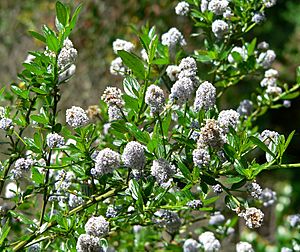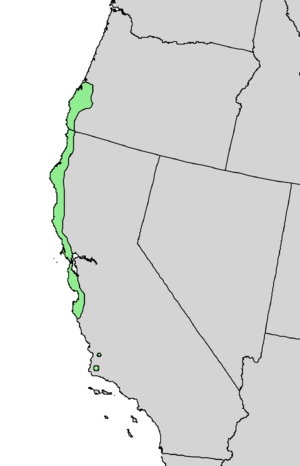Ceanothus thyrsiflorus facts for kids
Quick facts for kids Ceanothus thyrsiflorus |
|
|---|---|
 |
|
| Scientific classification | |
| Genus: |
Ceanothus
|
| Species: |
thyrsiflorus
|
 |
|
| Natural range of Ceanothus thyrsiflorus | |
| Synonyms | |
|
|
Ceanothus thyrsiflorus, often called blueblossom or blue blossom ceanothus, is a type of evergreen shrub. It belongs to the genus Ceanothus. This plant grows naturally only in Oregon and California. Some people also call it 'Californian lilac', but it's not actually related to the true lilac plant.
What it Looks Like
Ceanothus thyrsiflorus can grow quite tall, sometimes over 6 meters (about 20 feet) high. It grows in its natural home, which is a type of scrubland called chaparral. The flowers of this plant can be many shades of blue, and some are even close to white.
This plant is very popular with birds, butterflies, and other pollinators. Honeybees often visit it to collect its pollen. This helps the plant make seeds and grow more plants.
Growing Blueblossom Plants
People often plant Ceanothus thyrsiflorus in gardens. There are several special types, called cultivars, that have been chosen for gardens. Here are some popular ones:
- 'Blue Mound' can grow up to 1.5 meters (about 5 feet) tall.
- 'Cascade' can reach heights of 8 meters (about 26 feet).
- 'El Dorado' is a special type with gold edges on its leaves and light blue flowers.
- 'Repens' stays as a smaller shrub, usually between 1 and 3 meters (3 to 10 feet) tall.
- 'Repens Victoria' forms a strong, evergreen mound. It's a good plant to cover the ground and has light blue flowers.
- 'Skylark' is a tall type with blue flowers. This one has won an important award called the Royal Horticultural Society's Award of Garden Merit.
- 'Snow Flurry' has white flowers instead of blue.
Where the Name Comes From
The name Ceanothus comes from an Ancient Greek word, keanothos. This word means 'spiny plant'. The ancient Greek writer Theophrastus first used this name for a different plant. Later, Linnaeus, a famous scientist, reused it for the Ceanothus plants we know today.
The second part of the name, thyrsiflorus, also comes from Ancient Greek and Latin. Thyrsos (θύρσος) means a 'contracted panicle' or a 'wreath'. A panicle is a type of flower cluster. The Latin word florum means 'flower'. So, thyrsiflorus means 'with flowers arranged like a contracted panicle' or a special staff called a thyrsos.

